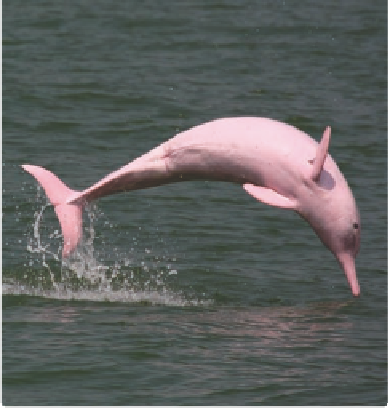Travel Reference
In-Depth Information
371 pink dolphins in hong
kong haRBouR
372 take the tRans-Mongolian
expRess
Hong Kong - one of the most densely populated
urban centres on Earth - hardly sounds like
a place where you'd encounter dolphins. Pink
dolphins at that: a surreal rose-coloured strain
of river dolphin that became the official mascot
for the handover of sovereignty in 1997.
Fantastic as they are, these fairytale creatures
may not be with us much longer. Faced with
chronic pollution of their waters, habitat loss and
overfishing of their food sources, the population
left in Hong Kong is now suspected to be fewer
than a hundred. One of the best ways to help
them survive is to take a boat trip with HK
Dolphinwatch, which uses visitor fees to raise
awareness of the dolphins' plight and demonstrate
their economic value as a tourist attraction.
As you cruise through the crowded shipping
lanes of one of the world's busiest harbours, your
guide will explain about this curious creature
and the threats it faces. All the while, everyone
will be on the lookout for tell-tale flashes of pink
in the water. If by chance you don't see them
- and on 97 percent of tours you do - you'll get a
free ride next time.
And in case you wonder why they're pink: the
dolphins pump blood towards the surface of their
skin to regulate their
body temperature. Or
less scientifically, they
blush.
Even after seven unbroken days on a train from
Moscow, nothing can prepare you for the Chinese
border. As you pull into the platform, which is lit
up in neon colours, a Chinese-tinged version of
the Vienna Waltz comes blaring over the Tannoy.
Trying to work out the cultural relevance
of this is a hopeless task, as the tune soon
changes - moving through the works of Richard
Clayderman before finishing as you draw away
with a stirring rendition of Beethoven's Fifth.
As the music fades, the train rolls into a vast
shed manned with soldiers and workers in
hard hats. Each carriage is then separated and
raised on hydraulics, the wheels removed and
new narrower ones rolled into place to match
the Chinese gauges - the whole process lasting
almost two hours. All while the passengers are
still on board.
This isn't the Trans-Siberian railway (which
goes to Vladivostok) but its more tourist-friendly
sister the Trans-Mongolian, which veers south
just after Lake Baikal, stopping in Ulaan
Bator on its way to Beijing. The first few days
showcase the vastness of the forested Russian
landscape, so that as you approach Lake Baikal
early on day four, the sight of contours and water
is a bit of relief - though it soon gives way to the
barren steppe and then desert of Mongolia.
At times the train has quite a party
atmosphere, with travellers playing cards,
swapping anecdotes or eating and drinking in
the restaurant car, which is replaced at each
border by a new car serving food from and
run by members of the country you're passing
through. The best is the Mongolian, but more for
the ornate woodcarvings and wall-hangings than
because the food is much to remember.
Buy your ticket in Moscow and it is probably
the best-value form of intercontinental transport
imagineable, especially if you get one of the
two-person “first class” cabins - en-suite and
complete with armchair and writing desk. Along
Pink dolphins in Hong Kong
Need to know
Trips
take around three
hours and run every
Wednesday, Friday and
Sunday; guests are
picked up from Kowloon
Hotel in Tsim Sha Tsui.
For times, fares and
bookings see
W
www.
hkdolphinwatch.com;
T
+852 2984 1414.























Search WWH ::

Custom Search